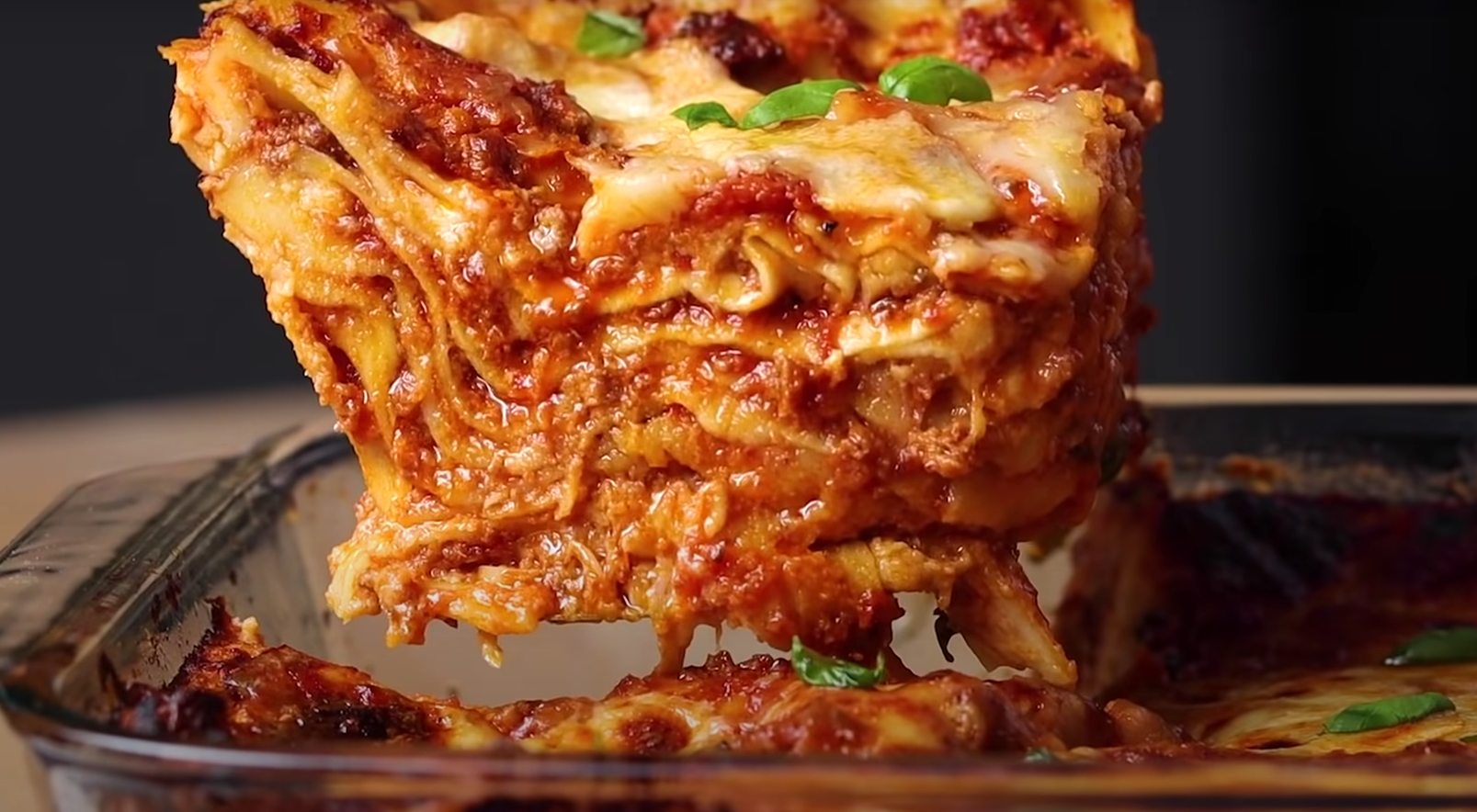Are you wondering how long to cook lasagna? If so, you’re in the right place. Lasagna is one of those dishes that can seem overwhelming, but with a few basic tips and techniques, it”s easy to master. In this blog post, we’ll guide you through everything you need to know about baking lasagna including an overview of ingredients needed for classic and vegetarian versions as well as advice about choosing the right size pan for your ingredients and recommending temperature settings and cooking times. So whether you just want a quick answer to “how long do I cook my lasagna?” or if more detailed steps are what you seek then read on.
Contents
What Is Lasagna And Its Origins?

Lasagna, also known as lasagne, has its origins rooted in Ancient Greece. The term “lasagne” is derived from “laganon,” which was the earliest form of pasta consisting of flat sheets of pasta dough cut into thin strips.
How To Make The Perfect Lasagna?
Ingredients:
- Lasagna noodles
- Ground beef or vegetarian meat substitute (such as lentils)
- Tomato sauce
- Ricotta cheese
- Mozzarella cheese, shredded
- Parmesan cheese, grated
Directions:
- Preheat your oven to 375°F (190°C).
- Cook the lasagna noodles according to package instructions and set aside.
- In a skillet, cook the ground beef or vegetarian meat substitute until browned and set aside.
- In a mixing bowl, mix together the ricotta cheese and Parmesan cheese.
- In an appropriate size baking dish, spread a layer of tomato sauce followed by lasagna noodles on top.
- Add another layer of tomato sauce followed by the cooked ground beef or vegetarian meat substitute.
- Spread a layer of the ricotta cheese mixture on top, followed by more tomato sauce and lasagna noodles.
- Continue to repeat layers until all ingredients are used up, ending with a top layer of lasagna noodles.
- Sprinkle shredded mozzarella cheese on top and cover with foil.
- Bake in the preheated oven for 25 minutes, then remove the foil and bake for an additional 25 minutes until the cheese is melted and bubbly.
How Long To Cook Lasagna?
The cooking time for lasagna can vary based on the size and depth of your baking dish, as well as the ingredients used. Generally, lasagna needs to bake in the oven for 50-60 minutes at 375°F (190°C). However, if you are using a larger or deeper baking dish, you may need to increase the cooking time by an additional 10-15 minutes. It’s also essential to check the lasagna periodically while it’s baking to ensure that the top layer of cheese does not burn.
Common Mistakes People Make When Cooking Lasagna
- Overcooking the Noodles:
If you’re using no-boil noodles, it’s not a real lasagna but a baked pasta dish.
If using boiled noodles, undercook them by boiling for 4 to 5 minutes, as they will cook again in the oven.
- Letting the Noodles Get All Clumpy:
Instead of dumping the drained noodles in a colander, lay them flat on an oiled baking sheet or stack them between layers of parchment.
- Skipping the Béchamel Sauce:
Lasagna requires both a tomato-based marinara sauce and a béchamel sauce.
Alternatively, you can make a meat ragú with plenty of milk or cream to incorporate dairy into the dish and counterbalance the acidity of the tomatoes.
Tips For Making The Best Lasagna

- Make sure to use enough sauce to prevent the noodles from becoming dry and hard.
- Let the lasagna rest for 10-15 minutes after removing it from the oven before cutting into it. This will allow the ingredients to set and make slicing easier.
- Experiment with different types of meat and vegetarian substitutes, as well as vegetables like spinach or zucchini, to customize your lasagna to your preferences.
- Consider adding a layer of shredded chicken or sausage for additional protein and flavor.
- Don’t be afraid to get creative with the cheese – try using a mix of different types, such as provolone or fontina, in addition to the classic mozzarella and Parmesan. Overall, making lasagna is all about finding the right balance of flavors and textures, so feel free to experiment and make it your own. So go ahead and give this recipe a try, and impress your family and friends with the perfect lasagna.
The Benefits Of Using Different Types Of Cheese In Lasagna
While mozzarella and Parmesan are the classic cheeses used in lasagna, there are many other types of cheese that can elevate the dish further. Here are some benefits of using different types of cheese in your lasagna:
- Adds flavor: Different types of cheese have unique flavors that can bring depth to your lasagna. For example, provolone has a tangy and nutty taste, while fontina has a milder and slightly sweet flavor.
- Changes texture: Using different types of cheese can also add variety in texture to your lasagna. For instance, adding ricotta or cottage cheese adds creaminess and moisture to the dish.
- Enhances appearance: Adding a layer of colorful cheese, such as cheddar or Gouda, can make your lasagna more visually appealing.
- Personalization: With so many types of cheese available, you can personalize your lasagna to your liking by experimenting with different combinations of cheese.
How To Reheat And Store Leftover Lasagna?

To ensure a satisfying reheating experience for leftover lasagna, follow these steps.
- Preheat your oven to 350˚F.
- Place the lasagna (in an oven-safe dish) in the oven.
- Cover the lasagna with aluminum foil.
- Allow the lasagna to heat for approximately 30 minutes, or until it is thoroughly heated and the sauce is bubbling at the edges.
- Remove from the oven and serve.
As for storing leftover lasagna, it is recommended to place it in an airtight container and refrigerate for up to 3-4 days or freeze it for longer storage.
Keep Exploring New Dishes With Your Next Lasagna Meal
Making lasagna is a great opportunity to experiment with different flavors and ingredients. So why not take it a step further and explore other dishes that use similar ingredients? For example, you can try making stuffed shells with the same ricotta cheese mixture used in lasagna or use the leftover ground beef to make meatballs for spaghetti. You can also incorporate the tomato sauce into other dishes, such as chicken Parmesan or eggplant Parmesan. With a little bit of creativity, you can turn one meal into multiple delicious creations.
FAQ: Cook Lasagna
How many minutes do you cook lasagna pasta?
Dried lasagna noodles require cooking for approximately 11 to 15 minutes until fully cooked. To prevent excessive sogginess during baking, it is advisable to reduce the cooking time by half. Additionally, ensure using a pot that can accommodate the length of the lasagna noodles for even cooking.
Can you overcook lasagna in the oven?
It is possible to overcook lasagna in the oven if it is cooked for an extended time beyond the recommended duration. It is crucial to monitor the baking process and adjust the cooking time accordingly to achieve the desired result.
Why should you not cover lasagna in a metal pan with foil?
The reason you should avoid covering lasagna in a metal pan with foil is that acidic foods like tomato sauce can have adverse reactions when exposed to foil under the heat of the oven. This information comes from Brian Owenby, chef at the Choctaw Nation of Oklahoma.

At the age of 25, chef and owner Michael Scognamiglio opened with confidence Bacco Italian restaurant.







